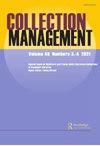Case Study: Reclassifying a Children’s and Young Adult Literature Collection
IF 0.5
Q4 INFORMATION SCIENCE & LIBRARY SCIENCE
引用次数: 0
Abstract
Abstract The Children’s and Young Adult Literature Collection at Michigan State University is more than five years old and was born out of a need to support the teacher education curriculum. The collection focuses on award-winning books as well as those with a diverse aspect either in author, character, and/or subject. The collection was started in collaboration with faculty in the College of Education’s teacher education department and initially funded through a diversity grant. At the time the collection was built, it was decided that it would be classified in LCC call numbers as it is housed within a main academic library as a specialty sub-collection (rather than in a curriculum materials center or a dedicated education library). This collection is among the most widely circulated in the library and is robustly used by students in the program. The focus for these past few years has been on building the collection and maintaining the relationships that the collection supports. Over time, the collection has grown substantially and more space was allotted to accommodate it. Using LC classification made sense initially but as the collection expanded, it became somewhat unwieldy. After observing students using the collection, it was apparent that a reorganization of the collection would remove numerous pain points including obstacles to discovery. The timing was serendipitous; a new education librarian with teaching experience and expertise in children’s literature had just started and was eager to undertake such a project. This case study will explain all the steps of undertaking this project and include both public services and technical services perspective. Both are essential in considering such an undertaking. Early discussions of the project resulted in a decision to reclass titles from LCC to Dewey, and to abandon the somewhat arbitrary division of picture books and chapter books in favor of an array of shelving categories: fiction, nonfiction, poetry, and graphic novels, with age range designations of children’s, middle grade, and young adult. These decisions involved cataloger re-training, changes to labeling and shelving procedures, and space considerations. The authors will explain the rationales behind these decisions and methods used to implement them.案例研究:对一本儿童和青少年文学集的重新分类
摘要密歇根州立大学的《儿童和青年文学集》已有五年多的历史,是出于支持教师教育课程的需要而诞生的。该系列侧重于获奖书籍以及作者、人物和/或主题多样化的书籍。该收藏是与教育学院教师教育系的教师合作开始的,最初通过多样性拨款资助。在建立藏品时,决定将其分类在LCC呼叫号码中,因为它作为专业子藏品存放在一个主要的学术图书馆内(而不是课程材料中心或专门的教育图书馆)。这些藏品是图书馆中流传最广的藏品之一,在该项目中被学生们大量使用。过去几年的重点一直放在建立藏品和维护藏品所支持的关系上。随着时间的推移,藏品数量大幅增长,并分配了更多的空间来容纳它。最初使用LC分类是有意义的,但随着藏品的扩大,它变得有些笨拙。在观察了学生使用该系列后,很明显,对该系列的重组将消除许多痛点,包括发现的障碍。时机是偶然的;一位具有儿童文学教学经验和专业知识的新教育图书管理员刚刚开始,并渴望承担这样一个项目。本案例研究将解释实施该项目的所有步骤,并包括公共服务和技术服务视角。在考虑这一承诺时,两者都至关重要。对该项目的早期讨论导致决定将LCC的书名重新归类为杜威,并放弃对图画书和章节书的武断划分,转而选择一系列搁置类别:小说、非小说、诗歌和图画小说,年龄范围为儿童、中学和青年。这些决定涉及编目员的重新培训、标签和货架程序的更改以及空间方面的考虑。作者将解释这些决定背后的理由以及执行这些决定的方法。
本文章由计算机程序翻译,如有差异,请以英文原文为准。
求助全文
约1分钟内获得全文
求助全文
来源期刊

Collection Management
INFORMATION SCIENCE & LIBRARY SCIENCE-
CiteScore
1.60
自引率
44.40%
发文量
18
期刊介绍:
The management and development of library collections is constantly evolving. Collection Management is the essential refereed quarterly journal that presents practical, research-based information about building, administering, preserving, assessing, and organizing library collections. The journal offers library professionals of all types crucial guidance in the fast-changing field of collection management, including the latest developments in sharing and providing access to resources, creating digital collections, preserving both traditional and digital library resources, applying technological developments to managing collections, training and developing staff.
 求助内容:
求助内容: 应助结果提醒方式:
应助结果提醒方式:


